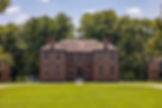Feature: A road trip through history in King William County
- visitwestpointkingwilliam
- Sep 8
- 5 min read

By James F. Lee
August 4, 2025
Mangohick. Central Garage. Romancoke. These are just some of the intriguing names of the tiny crossroads my wife, Carol, and I passed on our roughly 40-mile journey along Virginia Route 30, also known as King William Road.
This is King William County, a rural, tree-covered corner on Virginia’s Middle Peninsula. Rich in history and culture, the county is home to the Pamunkey and the Mattaponi Indian reservations, the oldest reservations recognized by the Commonwealth of Virginia.
Carol and I love history and travel, especially exploring out-of-the-way places that travelers often overlook. So we set our sights on King William County, originally called King and Queen County (for King William III—who ruled England from 1689 to 1702—and his wife Queen Mary, namesakes of the nearby William and Mary College in Williamsburg).
The county might not be home to many people, but it teems with history.

1. Peruse 10,000-year-old artifacts

Carol and I traveled east along King William Road from Mangohick to West Point, with some delightful detours along the way. At our first stop, the King William County Historical Society Museum, we learned that humans have inhabited the land between the Pamunkey and Mattaponi rivers for more than 10,000 years.
Native American arrowheads on display here date as far back as 8000 BC—these are a favorite with school groups visiting the museum, says Museum Council Chair Debra Moren. We also admired a portrait of King William III, a 2,000-year-old Pamunkey clay pot, and a painting of Cockacoeske, Queen of the Pamunkey.

The first African slaves arrived in King William County in the 1650s as tobacco was introduced. A tax book from 1815 illustrates this painful history, showing a plantation owner assessed $4.90 for ownership of 12 slaves.
Next door, visit the exquisitely preserved King William County Court House, which just celebrated its 300th anniversary. It’s the oldest courthouse in continuous use in the U.S.
Info: Museum open 1–5 p.m. Sundays (or by appointment), March through November.
2. Admire a restored 1700s-era church

Continuing southwest on Route 30, we stopped at Old St. John’s Church, built between 1732 and 1734 in a Flemish bond brick pattern. A 1760s addition made the T-shaped building we see today, and arched windows let in ample light.

Though the church fell into disrepair between 1800 and 1890, the interior has been lovingly restored to reflect its 18th-century appearance with simple white walls, box pews, and a raised pulpit with a sounding board above. The balcony and choir loft are original.

Carter Braxton, a signer of the Declaration of Independence, was a parishioner here when it was an Anglican church. His political views were not universally supported by church members.
“Before the Revolution, the congregation was split between Loyalists and Rebels,” says Carl Fischer, past president of the St. John’s Church Restoration Association.
Regular services are no longer held, but the church is open for special events. Each year on the fourth Sunday in September, St. John’s holds a homecoming service for descendants of long-ago church members.
Info: To see the church interior, call 804-246-9593 ahead of your trip.
3. Visit a Colonial manor

Slave labor predominated in King William County for much of its history. About a dozen plantation houses remain, all of them privately owned.
One of them is Elsing Green, an impressive two-story Colonial brick manor built in a U-shape overlooking the Pamunkey River. The manor is located at the end of a mile-long drive lined with gorgeous willow oaks, just off Route 632.

A dependency on the east side of the house dates to 1690; the Dandridge family built the manor house between 1715 and 1720.
Info: The house is not open for scheduled tours, but those who are interested can call 804-769-3416 to arrange a visit.
4. Sip and snack

Mattapony Reserve owners Ginger Custalow and Mattaponi Tribe member Lonnie Custalow envisioned a winery whose visitors would experience the ecology, culture, and history of the place where the grapes are grown. “Patrons would miss all of that if they just buy their wine in a grocery store,” Ginger says.

The Custalows opened their riverside winery in 2022—although not owned by the tribe, it’s located on the Mattaponi Reservation (Mattapony is an alternate spelling, dating from the 16th century) and is open for wine tasting and purchase. On weekends, they also serve locally sourced cuisine in a full-service restaurant.

Carol and I sampled several whites and reds in the tasting room before each selecting a glass of dry red. Ginger pointed out that their wines, made from 100% Virginia grapes, are all natural with no sulfites, additives, or preservatives.

Later, on the deck overlooking the Mattaponi River, we enjoyed the winery’s signature dish: baked Virginia bison meat pie with a flaky crust. The rotating menu of entrées and desserts includes a charcuterie board and bison burger.
The Custalows are also certified eco tour guides. They lead kayak trips from the winery for those who want to learn about local ecology and Mattaponi culture while gliding along the river.
Info: The winery hosts a happy hour from 5 to 6 p.m. on Fridays and is open from noon to 6 p.m. on Saturdays and Sundays. Kayak trips are $75 for a two-person tandem kayak.
5. Explore a waterfront town
Our historical road trip ended at West Point, King William County’s only town, where the Pamunkey and Mattaponi rivers meet to form the York River.
This was the approximate location of Cinquoteck, an important Native settlement at the time Europeans arrived in Virginia. The Marquis de Lafayette and French troops encamped here before the Battle of Yorktown. In the late 1800s, oystering and tourism were mainstays of the economy and oystering sheds were common sights.

Today, the town features pleasant tree-lined residential streets and a small downtown. A boardwalk on the Mattaponi side of West Point passes along wetlands and the riverbank. A large paper plant dominates the Pamunkey side.

On the first weekend in October, the annual Crab Carnival draws more than 10,000 visitors to the West Point waterfront for food, beverages, live music, and a parade.

A standout for food is the crab cake sandwich at The Blue Crab on Main Street in West Point.
***
Thank you to AAA Magazines for this great feature about King William County and the Town of West Point! For more to see and do right here in WP + KW, including lodging and dining options, check out visitwestpointkingwilliam.com/planvisit.


